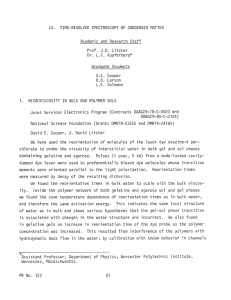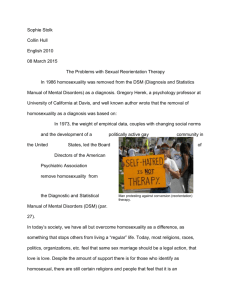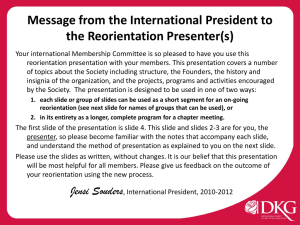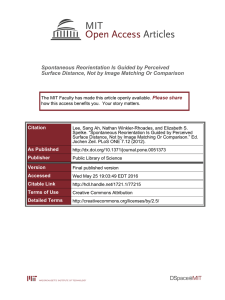IX. TIME-RESOLVED SPECTROSCOPY OF CONDENSED MATTER
advertisement
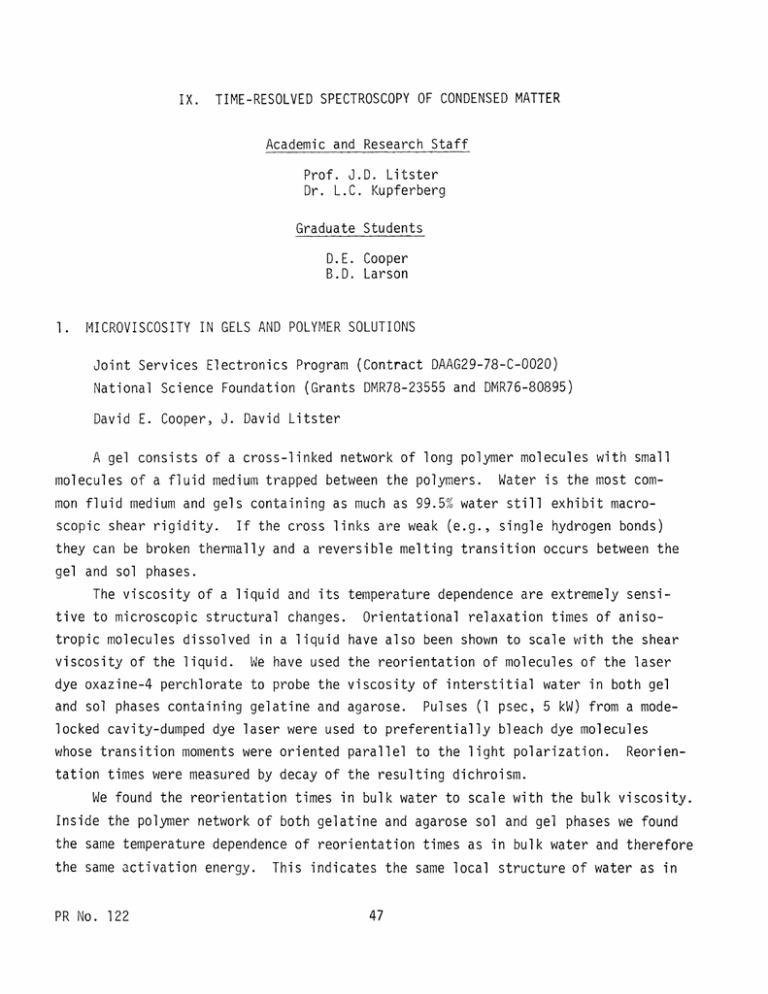
IX. TIME-RESOLVED SPECTROSCOPY OF CONDENSED MATTER Academic and Research Staff Prof. J.D. Litster Dr. L.C. Kupferberg Graduate Students D.E. Cooper B.D. Larson 1. MICROVISCOSITY IN GELS AND POLYMER SOLUTIONS Joint Services Electronics Program (Contract DAAG29-78-C-0020) National Science Foundation (Grants DMR78-23555 and DMR76-80895) David E. Cooper, J. David Litster A gel consists of a cross-linked network of long polymer molecules with small molecules of a fluid medium trapped between the polymers. Water is the most common fluid medium and gels containing as much as 99.5% water still exhibit macroscopic shear rigidity. If the cross links are weak (e.g., single hydrogen bonds) they can be broken thermally and a reversible melting transition occurs between the gel and sol phases. The viscosity of a liquid and its temperature dependence are extremely sensitive to microscopic structural changes. Orientational relaxation times of anisotropic molecules dissolved in a liquid have also been shown to scale with the shear viscosity of the liquid. We have used the reorientation of molecules of the laser dye oxazine-4 perchlorate to probe the viscosity of interstitial water in both gel and sol phases containing gelatine and agarose. Pulses (1 psec, 5 kW) from a modelocked cavity-dumped dye laser were used to preferentially bleach dye molecules whose transition moments were oriented parallel to the light polarization. Reorientation times were measured by decay of the resulting dichroism. We found the reorientation times in bulk water to scale with the bulk viscosity. Inside the polymer network of both gelatine and agarose sol and gel phases we found the same temperature dependence of reorientation times as in bulk water and therefore the same activation energy. PR No. 122 This indicates the same local structure of water as in (IX. TIME-RESOLVED SPECTROSCOPY OF CONDENSED MATTER) bulk and shows various hypotheses that the gel-sol phase transition is associated with changes in the water structure are incorrect. We also found in gelatine gels an increase in reorientation time of the dye probe as the polymer concentration was increased. This resulted from interference of the polymers with hydrodynamic back flow in the water; by calibration with known behavior in channels of Vycor glass we could estimate the effective pore size in the gel-polymer solution. This varies from 35 A to 20 A in 2% to 10% gelatine gels and is in good agreement with estimates by other methods. 2. MOLECULAR REORIENTATION NEAR THE CONSOLUTE CRITICAL POINT Joint Services Electronics Program (Contract DAAG29-78-C-0020) National Science Foundation (Grants DMR78-23555 and DMR76-80895) David E. Cooper, J. David Litster Nitrobenzene and n-hexane are mutually soluble in any concentration at temperatures greater than about 21'C. Below this critical temperature the contribution of the mixing entropy to the free energy is so small that the mixture separates into two phases, one rich in nitrobenzene, the other in hexane. This type of critical behavior is accompanied by divergences in such quantities as the osmotic compressibility and the coherence length for concentration fluctuations. The static properties of the system have been well characterized experimentally and a satisfactory theoretical explanation is provided by applying the renormalization group method of statistical mechanics to the lattice gas (Ising) model. A mode-mode coupling theory 1 of Kawasaki also provides a good description of the critical behavior of transport properties such as the thermal diffusivity. The effect of the critical-order parameter fluctuations on molecular reorientation is less well understood. We have used the electric field of the laser pulse to induce a small amount of orientation order (Kerr effect) of the nitrobenzene molecules and studied its relaxation by using a delayed probe pulse to measure the birefringence as a function of time. The order we induced and measured has quadrupolar symmetry and the orientational-order parameter can be represented as a secondrank tensor PR No. 122 (IX. TIME-RESOLVED SPECTROSCOPY OF CONDENSED MATTER) 1 < Q~ <" - , are the Cartesian components of the symmetry axis C of the molecules and the average is performed over a small but macroscopic volume. The anisotropy in the optical-frequency dielectric-constant tensor (the birefringence) is proportional to where cacg QaB. A phenomenological model for the dynamical behavior of Q B can be obtained by the same procedure used to describe short-range-order effects in the isotropic phase of a liquid crystal.2 This predicts an exponential relaxation Qa (t) = QB(O) e -t/ r, where the relaxation time T is given by T = VX. Here X is a generalized susceptibility, expected to be only weakly temperaturedependent, and the transport coefficient v may be expected to be proportional to the shear viscosity of the fluid.2 We find the reorientation time of nitrobenzene molecules varies from 6.5 psec to 11.1 psec as the reduced temperature t = T/Tc - 1 varies from 10 to 10 . A quantitative analysis of our data is consistent with a weak (t-0 045 ) divergence in agreement with renormalization group calculations1 for the temperature dependence of the shear viscosity. References 1. See the excellent review article by P.C. Hohenberg and B.I. Halperin, "Theory of Dynamic Critical Phenomena," Rev. Mod. Phys. 49, 435 (1977). 2. T.W. Stinson, J.D. Litster, and N.A. Clark, J. de Physique 33, CI-69 (1972). PR No. 122 (IX. TIME-RESOLVED SPECTROSCOPY OF CONDENSED MATTER) 3. FUTURE DIRECTIONS Lenn C. Kupferberg, Brent D. Larson, J. David Litster We have conducted preliminary experiments on molecular reorientation in the isotropic and nematic phases of the liquid crystal hexylcyanobiphenyl using dye -4 probes in 10-4 M concentration. These will be continued and extended to study the effect of orientational order on optical-energy transfer in liquid-crystal phases. We shall also initiate a program to study optical energy transfer in disordered solids; for some of these proposed experiments we shall have to modify our equipment to obtain pulses tunable over a wider range than we can now achieve. PR No. 122
